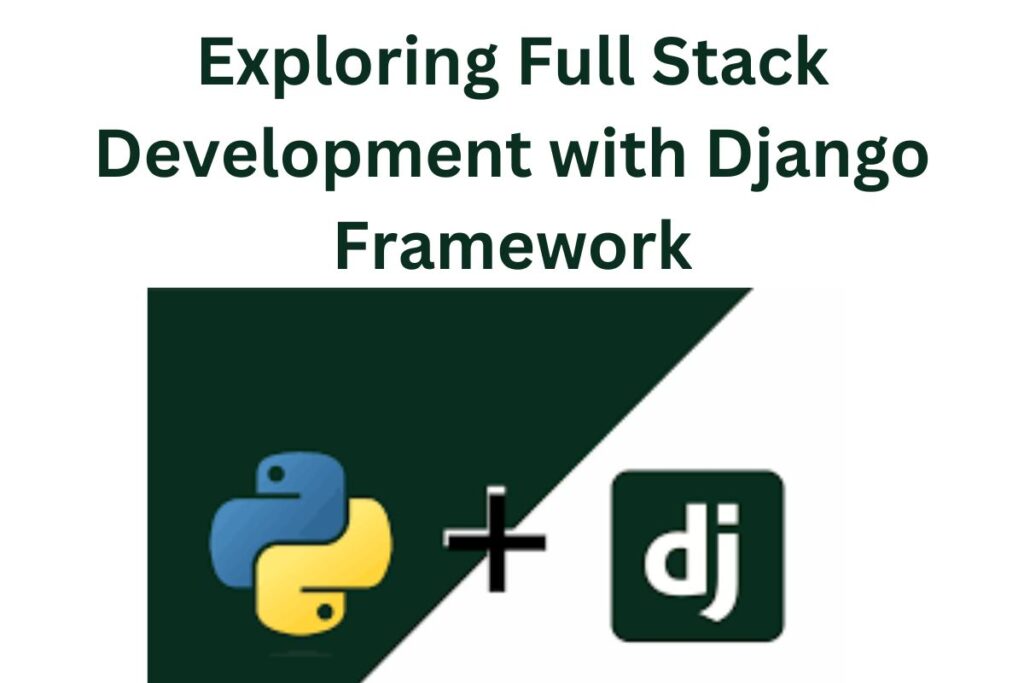Full Stack Development is a term that’s become incredibly popular in recent years, especially among those interested in web development. It refers to the development of both the front-end and back-end of web applications. In this guide, we will explore the role of Django in full stack development and why it’s an excellent framework for building powerful web applications.
What is Full Stack Development?
Before diving into Django, it’s important to understand what full stack development involves. Essentially, full stack development refers to working on both:
- Front-End: This is what the user interacts with directly in their web browser. It includes everything you see on a website like text, images, forms, and buttons. Front-end development focuses on creating an engaging and intuitive user experience through technologies like HTML, CSS, and JavaScript.
- Back-End: The back-end is the “server side” of the web application. It manages the logic, databases, and servers that keep the website running. It processes requests, stores information in databases, and ensures that the front-end is able to function smoothly. Popular back-end technologies include Python, PHP, Ruby, and JavaScript (Node.js).
A Full Stack Developer is someone who has the ability to work on both the front-end and back-end of a web application. They can create entire web applications from scratch, which is why full stack development is such a valuable skill.
Introduction to Django Framework
Django is a powerful and widely-used web framework that simplifies the process of full stack development. It was created using Python, one of the most popular programming languages in the world, known for being beginner-friendly and versatile.
Django is designed to help developers build complex web applications quickly and with minimal effort. It encourages clean, pragmatic design and follows the Model-View-Template (MVT) architecture, which helps in keeping the code organized and maintainable.
Key Features of Django:
- Rapid Development: Django comes with a lot of built-in tools and functionalities that help developers build web applications faster. This reduces the time spent on repetitive tasks.
- Security: Django has several security features built-in, which helps prevent common web attacks like SQL injection, cross-site scripting (XSS), and cross-site request forgery (CSRF). This makes Django a great choice for applications that need high-level security.
- Scalability: Django is built to handle applications of all sizes, whether it’s a simple blog or a complex web app with millions of users. It’s a great option for growing businesses.
- Versatility: Django can be used for a variety of web applications, from content management systems (CMS) to social media platforms or even e-commerce websites.
Why Django is Ideal for Full Stack Development
- Python-Based Framework: Since Django is built on Python, it benefits from Python’s simplicity and readability. Python is often recommended for beginners, and Django carries forward that same ease of use, making it accessible to new developers.
- Complete Web Framework: Django is referred to as a “batteries-included” framework, meaning it has everything you need to build a fully functional web application. This includes tools for managing databases, form handling, user authentication, and more. This saves time for full stack developers who don’t want to spend extra time adding these features manually.
- Clean Code Structure: Django follows the Model-View-Template (MVT) pattern, which separates the business logic, user interface, and data handling components of an application. This separation makes the code easier to maintain and scale as the application grows.
- Strong Community Support: Django has a large and active community of developers. This means there is plenty of documentation, tutorials, and open-source libraries available. If you get stuck, chances are, someone else has already encountered the same problem and has shared the solution.
- Admin Interface: One of the standout features of Django is the built-in admin interface. With minimal configuration, Django automatically creates an administrative panel for managing your web application’s data, which saves developers a lot of effort.
- Compatible with Front-End Technologies: Although Django focuses on back-end development, it integrates smoothly with front-end technologies like JavaScript, HTML, and CSS. This makes it easier to develop modern, responsive web applications using frameworks like React or Vue.js for the front-end, while Django manages the back-end.
How Django Fits into the Full Stack Development Process
Let’s break down how Django plays a role in both the front-end and back-end aspects of full stack development:
Front-End Role:
- Django allows you to create dynamic web pages by integrating HTML templates with Python code. This makes it possible to render dynamic content like user data or form submissions on the website.
- Django’s template system lets developers build the user interface in a structured way, allowing them to reuse components like navigation bars or footers across multiple pages.
Back-End Role:
- Django handles everything from processing requests to interacting with databases. It allows developers to define models, which are the blueprint for how data is stored in the database.
- The framework automatically generates queries to interact with the database, saving developers from writing SQL code manually.
- Django’s ORM (Object-Relational Mapping) system helps developers easily work with databases without having to use complex SQL queries.
Benefits of Using Django for Full Stack Development
- Time-Saving: Django’s “batteries-included” approach means many essential features like authentication, admin panels, and database management are already built-in, reducing development time.
- Security: The framework takes care of many security risks, allowing developers to focus on building the application rather than spending extra time implementing security measures.
- Open Source: Django is free to use and open-source, which makes it a great option for businesses looking to reduce costs without sacrificing quality.
- Flexibility: Whether you’re building a small personal project or a large-scale web application, Django’s modular design allows you to scale your application with ease.
Conclusion
Full stack development is a crucial skill in today’s web-driven world, and using Django as your framework of choice offers numerous advantages. Its simplicity, scalability, and rich set of features make it an excellent choice for both beginner and professional developers. By mastering Django, you will be well-equipped to handle every aspect of web development—from designing a beautiful user interface to managing complex data systems.
If you’re just starting your journey in full stack development, or considering a Full stack developer course in Noida, Delhi, Gurgaon, and other locations in India, Django is a framework that will help you build projects quickly and efficiently while ensuring the security and maintainability of your web applications.
FAQs on Exploring Full Stack Development with Django Framework
1. What is Full Stack Development?
Full Stack Development involves working on both the front-end (user interface) and the back-end (server-side logic, databases) of a web application. Full stack developers have the skills to manage both sides of web development, creating fully functional and dynamic applications.
2. What is Django Framework?
Django is a high-level web framework based on Python that simplifies web development by providing tools and features that help developers build complex web applications quickly. It follows the Model-View-Template (MVT) architecture and includes everything needed to develop a fully functional web application.
3. Why should I use Django for Full Stack Development?
Django is ideal for full stack development because:
- It’s Python-based, which is beginner-friendly.
- It’s a complete web framework with built-in features for managing databases, user authentication, and more.
- It’s secure, scalable, and has strong community support.
- It integrates well with front-end technologies like HTML, CSS, and JavaScript.
4. What are the key features of Django?
Some of Django’s key features include:
- Rapid Development: Django offers pre-built tools that speed up development time.
- Security: It has built-in protection against common security threats.
- Scalability: Django can handle applications of all sizes.
- Admin Interface: Django automatically generates an admin panel for managing your application.
5. What is the Model-View-Template (MVT) architecture?
The MVT architecture separates the code into three components:
- Model: Defines the data structure and handles the database.
- View: Manages the logic and interactions between the user and the database.
- Template: Responsible for rendering the HTML and presenting the data to the user.
This structure helps in organizing the code, making it more maintainable and scalable.



